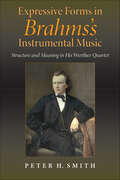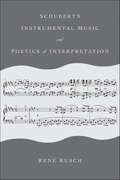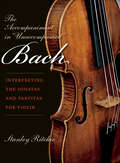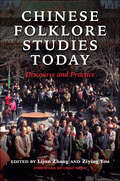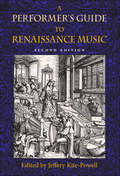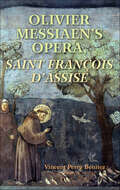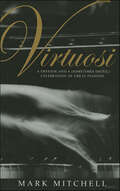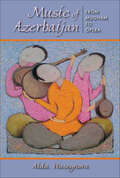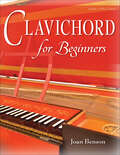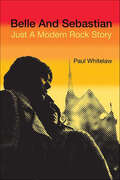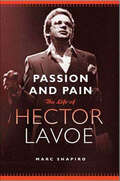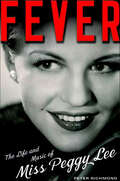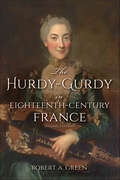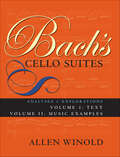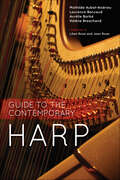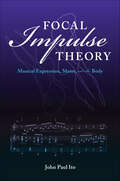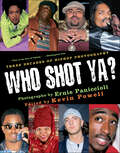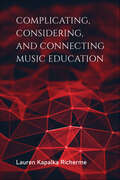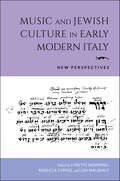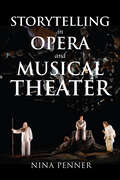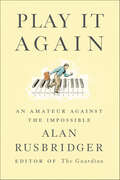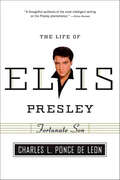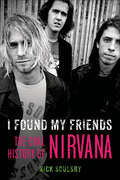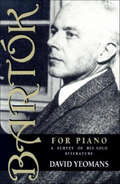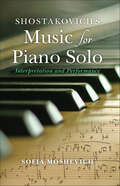- Table View
- List View
Expressive Forms in Brahms's Instrumental Music: Structure and Meaning in His Werther Quartet (Musical Meaning and Interpretation)
by Peter H. Smith"This book is a substantial and timely contribution to Brahms studies. Its strategy is to focus on a single critical work, the C-Minor Piano Quartet, analyzing and interpreting it in great detail, but also using it as a stepping-stone to connect it to other central Brahms works in order to reach a new understanding of the composer's technical language and expressive intent. It is an original and worthy contribution on the music of a major composer." —Patrick McCrelessExpressive Forms in Brahms's Instrumental Music integrates a wide variety of analytical methods into a broader study of theoretical approaches, using a single work by Brahms as a case study. On the basis of his findings, Smith considers how Brahms's approach in this piano quartet informs analyses of similar works by Brahms as well as by Beethoven and Mozart.Musical Meaning and Interpretation—Robert S. Hatten, editor
Schubert's Instrumental Music and Poetics of Interpretation
by René RuschMusic scholarship's views of Franz Schubert's instrumental works continue to evolve. How might aesthetic values, historiographies, revisions to the composer's biography, and disciplinary commitments affect how we interpret his music?Schubert's Instrumental Music and Poetics of Interpretation explores the aesthetic positions and operations that underlie critical assessments of Schubert's instrumental works. In six chapters, each devoted to one or two of Schubert's pieces, René Rusch examines the conditions that have prompted scholarship to reevaluate the composer's music and legacy, considers how different conclusions about his music may be reflective of certain aesthetic values, investigates the role of narrative in both music analysis and constructions of history, and explores alternative forms of coherence through updated analyses of the composer's instrumental works. Rusch's observations and comparative analyses address four significant areas of scholarly focus in Schubert studies, including his approach to chromaticism, his unique musical forms, the relationship between his music and biography, and the influence of Beethoven.Drawing from a range of philosophical, hermeneutic, historical, biographical, theoretical, and analytical sources, Schubert's Instrumental Music and Poetics of Interpretation offers readers a unique and innovative foray into the poetics of contemporary analyses of Schubert's instrumental music and develops new ways to engage with his repertoire.
The Accompaniment in "Unaccompanied" Bach: Interpreting the Sonatas and Partitas for Violin (Publications of the Early Music Institute)
by Stanley RitchieKnown around the world for his advocacy of early historical performance and as a skilled violin performer and pedagogue, Stanley Ritchie has developed a technical guide to the interpretation and performance of J. S. Bach's enigmatic sonatas and partitas for solo violin. Unlike typical Baroque compositions, Bach's six solos are uniquely free of accompaniment. To add depth and texture to the pieces, Bach incorporated various techniques to bring out a multitude of voices from four strings and one bow, including arpeggios across strings, multiple stopping, opposing tonal ranges, and deft bowing. Published in 1802, over 80 years after its completion in 1720, Bach's manuscript is without expression marks, leaving the performer to freely interpret the dynamics, fingering, bowings, and articulations. Marshaling a lifetime of experience, Stanley Ritchie provides violinists with deep insights into the interpretation and technicalities at the heart of these challenging pieces.
Chinese Folklore Studies Today: Discourse and Practice
by Edited by Lijun Zhang and Ziying YouChinese folklorists are well acquainted with the work of their English-language colleagues, but until recently the same could not be said about American scholars' knowledge of Chinese folkloristics. Chinese Folklore Studies Today aims to address this knowledge gap by illustrating the dynamics of contemporary folklore studies in China as seen through the eyes of the up-and-coming generation of scholars. Contributors to this volume focuses on topics that have long been the dominant areas of folklore studies in China, including myth, folk song, and cultural heritage, as well as topics that are new to the field, such as urban folklore and women's folklore. The ethnographic case studies presented here represent a broad range of geographic areas within mainland China and also introduce English-language readers to relevant Chinese literature on each topic, creating the foundation for further cross-cultural collaborations between English-language and Chinese folkloristics.
A Performer's Guide to Renaissance Music (Publications of the Early Music Institute)
by Jeffery Kite-PowellRevised and expanded since it first appeared in 1991, the guide features two new chapters on ornamentation and rehearsal techniques, as well as updated reference materials, internet resources, and other new material made available only in the last decade.The guide is comprised of focused chapters on performance practice issues such as vocal and choral music; various types of ensembles; profiles of specific instruments; instrumentation; performance practice issues; theory; dance; regional profiles of Renaissance music; and guidelines for directors. The format addresses the widest possible audience for early music, including amateur and professional performers, musicologists, theorists, and educators.
Olivier Messiaen's Opera, Saint François d'Assise
by Vincent Perez BenitezIn this comprehensive study of Olivier Messiaen's magnum opus, Saint François d'Assise, Vincent Perez Benitez examines the opera from both theological and musical-analytical perspectives to ask how Messiaen expresses his Catholic theology through his work. Benitez combines a close reading of the opera score with accounts from Messiaen's associates, studies of Messiaen's birdsong notebooks and other primary documents, and an examination of the religious, musical, poetic, and visual arts literature with which the composer was familiar to explore how the opera's harmonic language and sound-color relationships motivate its musical meaning and expression. Through his analysis of these diverse sources and comparisons of Saint François d'Assise with other works such as Berg's Wozzeck and Wagner's Parsifal, Benitez places Messiaen's compositional practice within larger musical perspectives and historical contexts.
Virtuosi: A Defense and a (Sometimes Erotic) Celebration of Great Pianists
by Mark MitchellVirtuosiA Defense and a (Sometimes Erotic) Celebration of Great PianistsMark MitchellA bravura performance!"Vigorous, opinionated, and always entertaining, here is a personal essayist of great charm and sincerity. Mitchell's erudition—his collection of odd and illuminating bits of knowledge—is always a delight and adds a sauce piquanteto the whole dish!" —Edmund White"...a literary work of real élan, vibrancy, and grace—the very qualities that in his view define the virtuoso. [Mr. Mitchell explores] the traditional linking of musical and sexual virtuosity, the ethical implications of the original instruments' movement, the near deification of Mozart in Anglo-Saxon culture, and, in a particularly witty section, the relationship of the virtuoso to his stool. Throughout, Mr. Mitchell's prose is humorous, intimate, and unapologeticaly polemical." —Cynthia OzickThe artistic merit of performers with superior technique has long been almost ipso facto denied. At last, Mark Mitchell launches a counterattack. In essays crackling with pianistic lore, Mitchell takes on topics such as encores, prodigies, competitions, virtuosi in film and literature, and the erotics of musical performance. Liszt, Horowitz, and Argerich share these pages with the eccentric Pachmann, Ervin Nyiregyh ("the skid-row pianist"), and Liberace. The illustrations include rare portraits of long-forgotten girl prodigies, historic concert programs, and stills from a lost 1927 film on Beethoven. Punctuating this celebration of personal voice are vignettes, running from the beginnings of the author's obsession with the piano to the particularities of concert-going in Italy (where he now lives).Mark Mitchell's piano studies led to a friendship with Vladimir Horowitz and other pianistic luminaries. With David Leavitt he co-authored Italian Pleasures and co-edited Pages Passed from Hand to Hand. He also edited The Penguin Book of International Gay Writing.
Music of Azerbaijan: From Mugham to Opera (Ethnomusicology Multimedia)
by Aida HuseynovaThis book traces the development of Azerbaijani art music from its origins in the Eastern, modal, improvisational tradition known as mugham through its fusion with Western classical, jazz, and world art music. Aida Huseynova places the fascinating and little-known history of music in Azerbaijan against the vivid backdrop of cultural life under Soviet influence, which paradoxically both encouraged and repressed the evolution of national musics and post-Soviet independence. Inspired by their neighbors to the East and West, Azerbaijani musicians enjoyed a period of remarkable creativity, composing and performing the first opera and the first ballet in the Muslim East, establishing the region's first Opera and Ballet Theater and Conservatory of Music, and discovering ways to merge the modal lyricism of mugham with the rhythmic dynamics of jazz. Drawing on previously unstudied archives, letters, and documents as well as her experience as an Azerbaijani musician and educator, Huseynova shows how Azerbaijani musical development was not a product of Soviet cultural policies but rather grew from and reflected deep and complex cultural processes.
Clavichord for Beginners (Publications of the Early Music Institute)
by Joan BensonWritten by Joan Benson, one of the champions of clavichord performance in the 20th century, Clavichord for Beginners is an exceptional method book for both practitioners and enthusiasts. In addition to detailing the historical origins of the instrument and the evolution of keyboard technique, the book describes the proper method for practicing fingering and articulation and emphasizes the importance of touch and sensitivity at the keyboard.
Belle and Sebastian: Just A Modern Rock Story
by Paul WhitelawIn the years since their first release, Belle and Sebastian have grown from a secretive cult concern into one of the most beloved and revered pop'n'roll bands in the world. Intelligent and sensitive, witty and original, beautiful and bold, their music inspires the kind of devotion not seen since The Smiths. Their continuing desire to push the boundaries of their vision has resulted in some of the most essential and idiosyncratic records of recent times. In this, the first biography of Belle and Sebastian, Paul Whitelaw traces their unpredictable personal and creative curve. With all original interviews and personal photos from the band Belle and Sebastian:Just A Modern Rock Story is the definitive account of the clandestine world and continuing rise of the unique and fascinating musical phenomenon that is Belle and Sebastian.
Passion and Pain: The Life of Hector Lavoe
by Marc ShapiroA definitive biography of Hector Lavoe's rise from Puerto Rico to stardom in New York that led to sold-out concerts and best-selling salsa albums, yet gave way to drug addiction, a strained marriage and tragedy.From the poverty-stricken streets of Ponce, Puerto Rico to the vibrant barrios of New York City, HECTOR LAVOE became the singer of all singers, and the driving-force behind the Salsa movement in the mid-1960s. His popularity rivaled that of his contemporaries, Tito Puente, Celia Cruz and Johnny Pacheco.Behind the music, Hector's life was filled with drugs, alcohol and women. An endless stream of tragedy plagued him, including a gun-related accident that killed his son, Hector's ninth floor jump from a hotel window, and his death in 1993 from AIDS. But Hector's pristine voice, one-of-a-kind stage performances, sold-out concerts and bestselling albums were what his fans remember most and what made him an international icon. His music brought joy to legions of people, and it continues today.Marc Shapiro's Passion and Pain is "A no-holds barred biography" (Uptown Magazine) of a fascinating life.
Fever: The Life and Music of Miss Peggy Lee
by Peter RichmondThe first major biography of the legendary singer—an enthralling accountof a charismatic artist moving through the greatest, most glamorous era of American music "I learned courage from Buddha, Jesus, Lincoln, and Mr. Cary Grant." So said Peggy Lee, the North Dakota girl who sang like she'd just stepped out of Harlem. Einstein adored her; Duke Ellington dubbed her "the Queen." With her platinum cool and inimitable whisper she sold twenty million records, made more money than Mickey Mantle, and along with pals Frank Sinatra and Bing Crosby presided over music's greatest generation. Yet beneath the diamonds she was still Norma Delores Egstrom, insecure and always looking for acceptance. Drawing on exclusive interviews and new information, Peter Richmond delivers a complex, compelling portrait of an artist and an era that begins with a girl plagued by loss, her father's alcoholism, and her stepmother's abuse. One day she gets on a train hoping her music will lead her someplace better. It does—to a new town and a new name; to cities and clubs where a gallery of brilliant innovators are ushering in a brand-new beat; to four marriages, a daughter, Broadway, Vegas, and finally Hollywood. Richmond traces how Peggy rose, right along with jazz itself, becoming an unstoppable hit-maker ("Fever," "Mañana," "Is That All There Is?"). We see not only how this unforgettable star changed the rhythms of music, but also how—with her drive to create, compose, and perform—she became an artist whose style influenced k.d. lang, Nora Jones, and Diana Krall. Fever brings the lady alive again—and makes her swing.
The Hurdy-Gurdy in Eighteenth-Century France (Publications of the Early Music Institute)
by Robert A. GreenThe hurdy-gurdy, or vielle, has been part of European musical life since the eleventh century. In eighteenth-century France, improvements in its sound and appearance led to its use in chamber ensembles. This new and expanded edition of The Hurdy-Gurdy in Eighteenth-Century France offers the definitive introduction to the classic stringed instrument. Robert A. Green discusses the techniques of playing the hurdy-gurdy and the interpretation of its music, based on existing methods and on his own experience as a performer. The list of extant music includes new pieces discovered within the last decade and provides new historical context for the instrument and its role in eighteenth-century French culture.
Bach's Cello Suites, Volumes 1 and 2: Analyses and Explorations
by Allen WinoldJ. S. Bach's Suites for Unaccompanied Cello are among the most cherished and frequently played works in the entire literature of music, and yet they have never been the subject of a full-length music analytical study. The musical examples herein include every note of all movements (so one needs no separate copy of the music while reading the book), and undertakes both basic analyses—harmonic reduction, functional harmonic analysis, step progression analysis, form analysis, and syntagmatic and paradigmatic melodic analysis—and specialized analyses for some of the individual movements. Allen Winold presents a comprehensive study intended not only for cellists, but also for other performers, music theorists, music educators, and informed general readers.
Guide to the Contemporary Harp
by Mathilde Aubat-Andrieu Laurence Bancaud Aurélie Barbé Hélène BreschandHarps and harp music have enjoyed a renaissance over the past century and today can be heard in a broad array of musical contexts. Guide to the Contemporary Harp is a comprehensive resource that examines the vibrant present-day landscape of the harp. The authors explore the instrument from all angles, beginning with organology; moving through composition, notation, and playing techniques; and concluding with the contemporary repertoire for the harp. The rapid diversification in these areas of harp performance is the result of both technological innovations in harp making, which have produced the electric harp and MIDI harp, and innovative composers and players. These new instruments and techniques have broadened the concept of what is possible and what constitutes harp music for today. Guide to the Contemporary Harp is an essential guide for any harpist looking to push the instrument and its music to new heights.
Focal Impulse Theory: Musical Expression, Meter, and the Body (Musical Meaning and Interpretation)
by John Paul ItoMusic is surrounded by movement, from the arching back of the guitarist to the violinist swaying with each bow stroke. To John Paul Ito, these actions are not just a visual display; rather, they reveal what it really means for musicians to move with the beat, organizing the flow of notes from beat to beat and shaping the sound produced. By developing "focal impulse theory," Ito shows how a performer's choices of how to move with the meter can transform the music's expressive contours. Change the dance of the performer's body, and you change the dance of the notes. As Focal Impulse Theory deftly illustrates, bodily movements carry musical meaning and, in a very real sense, are meaning.
Who Shot Ya?: Three Decades of HipHop Photography
by Ernie PaniccioliNearly thirty years ago, Ernie Paniccioli, considered by many to be the James Van Der Zee of the hiphop generation, began photographing graffiti art throughout New York City as well as the young people creating it. Armed with a 35-millimeter camera, Paniccioli literally recorded the beginning salvos of hiphop, today the most dominant youth culture on the planet. Be it Grandmaster Flash at the Roxy, a summer block party in the Bronx, the fresh faces of Jay-Z and Will Smith, the cocksure personas of Tupac Shakur, The Notorious B.I.G., and Eminem, or the regal grace of Lauryn Hill, Ernie Paniccioli has been there to showcase hiphop’s emerging talent.With more than 200 photographs that have been culled from a vast archive, Who Shot Ya? is the first major pictorial history of hiphop culture.
Complicating, Considering, and Connecting Music Education (Counterpoints: Music and Education)
by Lauren Kapalka RichermeIn Complicating, Considering, and Connecting Music Education, Lauren Kapalka Richerme proposes a poststructuralist-inspired philosophy of music education. Complicating current conceptions of self, other, and place, Richerme emphasizes the embodied, emotional, and social aspects of humanity. She also examines intersections between local and global music making. Next, Richerme explores the ethical implications of considering multiple viewpoints and imagining who music makers might become. Ultimately, she offers that music education is good for facilitating differing connections with one's self and multiple environments. Throughout the text, she also integrates the writings of Gilles Deleuze and Félix Guattari with narrative philosophy and personal narratives. By highlighting the processes of complicating, considering, and connecting, Richerme challenges the standardization and career-centric rationales that ground contemporary music education policy and practice to better welcome diversity.
Music and Jewish Culture in Early Modern Italy: New Perspectives (Music and the Early Modern Imagination)
by Lynette Bowring, Rebecca Cypess and Liza MalamutMusical culture in Jewish communities in early modern Italy was much more diverse than researchers originally thought. An interdisciplinary reassessment, Music and Jewish Culture in Early Modern Italy evaluates the social, cultural, political, economic, and religious circumstances that shaped this community, especially in light of the need to recognize individual experiences within minority populations. Contributors draw from rich materials, topics, and approaches as they explore the inherently diverse understandings of music in daily life, the many ways that Jewish communities conceived of music, and the reception of and responses to Jewish musical culture. Highlighting the multifaceted experience of music within Jewish communities, Music and Jewish Culture in Early Modern Italy sheds new light on the place of music in complex, previously misunderstood environments.
Storytelling in Opera and Musical Theater (Musical Meaning and Interpretation)
by Nina PennerStorytelling in Opera and Musical Theater is the first systematic exploration of how sung forms of drama tell stories. Through examples from opera's origins to contemporary musicals, Nina Penner examines the roles of character-narrators and how they differ from those in literary and cinematic works, how music can orient spectators to characters' points of view, how being privy to characters' inner thoughts and feelings may evoke feelings of sympathy or empathy, and how performers' choices affect not only who is telling the story but what story is being told. Unique about Penner's approach is her engagement with current work in analytic philosophy. Her study reveals not only the resources this philosophical tradition can bring to musicology but those which musicology can bring to philosophy, challenging and refining accounts of narrative, point of view, and the work-performance relationship within both disciplines. She also considers practical problems singers and directors confront on a daily basis, such as what to do about Wagner's Jewish caricatures and the racism of Orientalist operas. More generally, Penner reflects on how centuries-old works remain meaningful to contemporary audiences and have the power to attract new, more diverse audiences to opera and musical theater. By exploring how practitioners past and present have addressed these issues, Storytelling in Opera and Musical Theater offers suggestions for how opera and musical theater can continue to entertain and enrich the lives of 21st-century audiences.
Play It Again: An Amateur Against the Impossible
by Alan RusbridgerAs editor of the Guardian, one of the world's foremost newspapers, Alan Rusbridger abides by the relentless twenty-four-hour news cycle. But increasingly in midlife, he feels the gravitational pull of music—especially the piano. He sets himself a formidable challenge: to fluently learnChopin's magnificent Ballade No. 1 in G minor, arguably one of the most difficult Romantic compositions in the repertory. With pyrotechnic passages that require feats of memory, dexterity, and power, the piece is one that causes alarm even in battle-hardened concert pianists. He gives himself a year.Under ideal circumstances, this would have been a daunting task. But the particular year Rusbridger chooses turns out to be one of frenetic intensity. As he writes in his introduction, "Perhaps if I'd known then what else would soon be happening in my day job, I might have had second thoughts. For it would transpire that, at the same time, I would be steering the Guardian through one of the most dramatic years in its history." It was a year that began with WikiLeaks' massive dump of state secrets and ended with the Guardian's revelations about widespread phone hacking at News of the World. "In between, there were the Japanese tsunami, the Arab Spring, the English riots . . . and the death of Osama Bin Laden," writes Rusbridger. The test would be to "nibble out" twenty minutes per day to do something totally unrelated to the above.Rusbridger's description of mastering the Ballade is hugely engaging, yet his subject is clearly larger than any one piece of classical music. Play It Again deals with focus, discipline, and desire but is, above all, about the sanctity of one's inner life in a world dominated by deadlines and distractions.What will you do with your twenty minutes?
Fortunate Son: The Life of Elvis Presley
by Charles L. Ponce de LeonElvis Presley was celebrity's perfect storm. His sole but substantial contribution was talent, a fact Charles L. Ponce de Leon is careful to demonstrate throughout his wonderfully contextual Fortunate Son. Even as the moments of lucidity necessary to exercise that talent grew rarer and rarer, Elvis proved his musical gifts right up to the end of his life. Beyond that, however, he was fortune's child. Fortunate Son succinctly traces out the larger shifts that repeatedly redefined the cultural landscape during the 1950s, 1960s, and 1970s, using Elvis's life to present a brief history of American popular culture during these tumultuous decades.
I Found My Friends: The Oral History of Nirvana
by Nick SoulsbyI Found My Friends recreates the short and tempestuous times of Nirvana through the musicians and producers who played and interacted with the band. The guides for this trip didn't just watch the life of this legendary band—they lived it. Soulsby interviewed over 150 musicians from bands that played and toured with Nirvana, including well-known alternative and grunge bands like Dinosaur Jr., The Dead Kennedys, and Butthole Surfers, as well as scores of smaller, but no less fascinating bands.In this groundbreaking look at a legendary band, readers will see a more personal history of Nirvana than ever before, including Nirvana's consideration of nearly a dozen previously unmentioned candidates for drummer before settling on David Grohl, a recounting of Nirvana's famously disastrous South American shows from never-before-heard sources on Brazilian and Argentine sides, and the man who hosted the first ever Nirvana gig's recollections of jamming with the band at that inaugural event.I Found My Friends relives Nirvana's meteoric rise from the days before the legend to through their increasingly damaged superstardom. More than twenty years after Kurt Cobain's tragic death, Nick Soulsby removes the posthumous halo from the brow of Kurt Cobain and travels back through time to observe one of rock and roll‘s most critical bands as no one has ever seen them before.
Bartók for Piano: A Survey of His Solo Literature
by David Yeomans" . . . detailed and thorough . . . a wealth of information . . . David Yeomans deserves our thanks for a job exceedingly well done." —American Music Teacher" . . . a must for pianists . . . " —American Reference Book Annual"David Yeomans's study is certainly to be recommended for all good music libraries, pianists and students of Bartók." —The Music Review"Although there are currently more than 15 books in print about composer Béla Bartók, this short volume is unique in its focus on his complete oeuvre for solo piano. . . . Recommended for pianists, piano teachers, and students from lower-division undergraduate level and above." —Choice" . . . the entire book is indispensable for any of us before we play another Bartók piece." —Clavier"This work collects in one place an enormous number of 'facts' about the piano music of Bartók . . . for planning concerts and student repertoire, and as a survey of an important body of 20th-century music, this listing is valuable." —Library JournalThis chronological listing of more than 400 pieces and movements presents in convenient form essential information about each of Bartók's solo piano works, including its various editions, timing, level of difficulty, pertinent remarks by the composer, and bibliographical references to it.
Shostakovich's Music for Piano Solo: Interpretation and Performance (Russian Music Studies)
by Sofia MoshevichThe piano works of Dmitri Shostakovich (1906–1975) are among the most treasured musical compositions of the 20th century. In this volume, pianist and Russian music scholar Sofia Moshevich provides detailed interpretive analyses of the ten major piano solo works by Shostakovich, carefully noting important stylistic details and specific ways to overcome the numerous musical and technical challenges presented by the music. Each piece is introduced with a brief historic and structural description, followed by an examination of such interpretive aspects as tempo, phrasing, dynamics, voice balance, pedaling, and fingering. This book will be an invaluable resource for students, pedagogues, and performers of Shostakovich's piano solos.
